Koreans have traditionally placed great importance on education as a means for self-fulfillment as well as for social advancement. Modern schools were first introduced in the 1880s. After the founding of the Republic of Korea in 1948, the government began to establish a modern educational system, making six years of elementary school attendance mandatory since 1953.
Today, Korea boasts one of the highest literacy rates in the world. An emphasis on education is often cited as a primary source for Korea's rapid economic growth over the past four decades as it has produced the scientists, engineers and specialists needed as well as a well-educated labor pool generally.
The School System
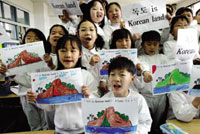
Elementary school pupils show their paintings of Dokdo, Korea's easternmost territory
The school system in the Republic of Korea consists of one to three-year pre-schools and kindergartens, six-year elementary schools, three-year middle schools, three-year high schools, and four-year colleges and universities, which also offer graduate courses leading to Ph.D. degrees. There are also two- to three-year junior colleges and vocational colleges. Elementary schooling is compulsory with an enrollment rate of nearly 100 percent. Three more years of compulsory middle school education have been implemented nationwide since 2002.
Although preschool education is not yet compulsory, its importance has been increasingly recognized in recent years. Preschool education is regarded as very important in terms of helping pull up the low birth rate, resolving social polarization, and allowing a greater number of women to work outside the home.
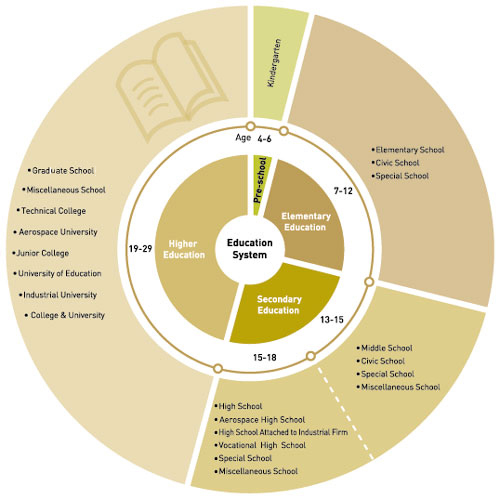
The number of kindergartens in Korea grew from 901 in 1980 to 8,294 in 2007. Since 1999, the Government has carried out a nationwide project to subsidize education fees for five-year-olds from low-income families. This was followed by a sliding scale subsidy for three- to four-year-olds in 2004 and a program to support education fees for households with two or more children. These measures have provided underprivileged children increased opportunities for preschool education, establishing a more equitable educational environment.
The average number of students per teacher in elementary schools stood at 58.8 in 1960. This figure was further cut to 24.0 in 2006. Elementary school teacher candidates are required to graduate from a four-year teachers' university or obtain an undergraduate degree in primary education from either Ewha Womans University or the Korea National University of Education.
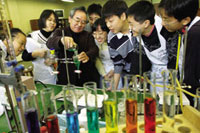
Middle school students studying chemistry in their laboratory
Upon completion of elementary school, children in the 12 to 14 age group enter middle school for the seventh to ninth grades. The student-teacher ratio for middle schools in 2006 was 19.4:1, while the comparable figure for 1975 was 43.2:1.
There are two types of high schools in the Republic: general and vocational. Applicants for vocational high schools (covering agriculture, engineering, commerce, maritime studies and home economics) are admitted through examinations administered by each school. The curriculum at vocational high schools is usually 40-60 percent general courses with the remainder being vocational. As of 2007, there were 702 vocational high schools with 494,011 students. Among general high schools, there are several specialized high schools in the arts, physical education, science, and foreign languages. The goal of these schools is to provide appropriate education for students with special talents in these fields.
Courses at general high schools tend to center around preparation for entering universities. As of 2007, there were 1,457 general high schools with 1.35 million students. Combining the two types of high schools, the ratio of middle school graduates advancing to high school was 99.6 in 2007.
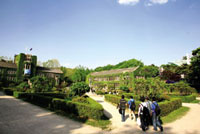
University students on campus
There are several different types of institutions of higher learning in the Republic: colleges and universities with four-year undergraduate programs (six years for medical and dental colleges), four-year teachers' universities, two-year junior colleges, a broadcasting and correspondence university, open universities, and miscellaneous schools with college status with two- or four-year programs. As of 2007, there were 408 institutions of higher learning in Korea, with a total of 3.56 million students and 70,957 faculty members.
Colleges and universities in Korea operate under strict enrollment limits. In selecting students, colleges and universities make use of the student's high school records and national standardized test results.
Special Education and Non-Formal Education
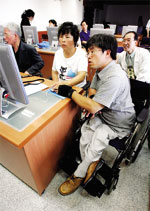
The disabled receive vocational training
People with disabilities may obtain an education in special schools as well as special and general classes within general schools. In 2007, a total of 65,944 students with disabilities received special education. Of this number, 22,963 students were given instruction in special schools, and 42,977 were mainstreamed in special and general classes in regular schools.
As of 2007, there were 144 special schools for persons with disabilities in the nation. These included seven for emotionally disturbed students, 12 for students with visual impairments, 18 for students with hearing impairments, 18 for students with physical disabilities and 89 for students with limited mental development.
With an increasing awareness of the needs of people with disabilities, there is also a growing effort to mainstream them in general schools. More and more general schools are appointing special education support staff and building facilities for students with disabilities. In order to accommodate students who have chronic problems, the government is also promoting the establishment of hospital schools.
To improve the quality of special education, the government established the Korea Institute for Special Education in 1994, which has been responsible for conducting research on special education and enhancing public awareness of the needs of those with disabilities.